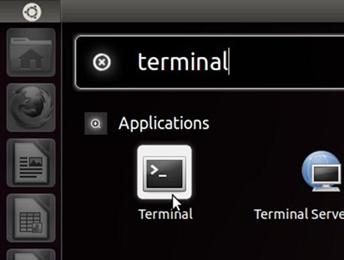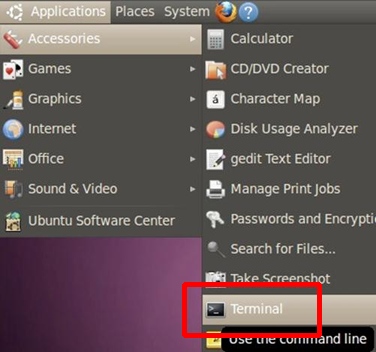Note: In order to access your Home Drive from a non-UBC internet connection, you must be connected to the myVPN service first.
Note: What you see on your screen may differ from the illustrations, depending on your distributed version of Linux. The examples below are from Ubuntu
Important: Please use the CWL username that gives you access to Workday.
To map your Home Drive, please follow these steps below:
- Ensure the cifs-utils package is installed on your system
- Open a Terminal session:
- In Ubuntu Unity, click the Ubuntu logo and type terminal

- Or in Gnome, click on Applications > Accessories > Terminal

- In Ubuntu Unity, click the Ubuntu logo and type terminal
- /mnt/<foldername> is where you wish to have your Home Drive mounted
<cwl> - is your CWL username
<linux_uid> - is the user id of your user on the local Linux system
<linux_gid> - is the group id of your user on the local Linux system
Using the Linux uid and gid will allow write access to the mounted directory as the corresponding localuser. If you are mounting as root, you can skip these parameters.
In the open Terminal session, enter the following commands
# First, fetch your UID & GID
$ id -u
<linux_uid>
$ id -g
<linux_gid>
# Next, make your mount point
$ sudo mkdir /mnt/<foldername>
# Finally, mount your Home Drive
#UBC V Employees
$ sudo mount.cifs //files.ubc.ca/<cwl> /mnt/<foldername> -o user=<cwl>,uid=<linux_uid>,gid=<linux_gid>,domain=ead,sec=ntlmssp
#UBC O Employees
$ sudo mount.cifs //files.ok.ubc.ca/<cwl> /mnt/<foldername> -o user=<cwl>,uid=<linux_uid>,gid=<linux_gid>,domain=ead,sec=ntlmssp
- Enter your password at the prompt
- If successful, all your Home Drive files will be located in the /mnt/<foldername> on your local machine